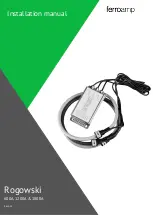
The SHoW DMX Wireless Data System
User’s Manual
Rev 1.4 11-17-08
33 of 48 Pages
that adjusting the Receiver Broadcast power has no effect during plain DMX
transmission. If RDM is not being used, you can leave the Receivers at the
default setting of 10mW.
Working with multiple DMX Universes
When multiple wireless systems are used in the same environment, SHoW DMX can
operate with up to 16 Transmitter/Universes in one system, and can operate with up to 8
Transmitter/Universes with little or no wireless data loss. In CTI Saturation tests
3
, 16
Transmitter/Universes were operated simultaneously with only 10-12% data loss and up
to 8 Universes were operated simultaneously with only 0-1% data loss.
For best results:
•
Observe all the installation guidelines noted above. Position the Transmitters
and Receivers up high and avoid having any barriers between Transmitters and
Receivers.
•
Locate Transmitters together in a horizontal row, spaced 6-24” apart. Do not
stack
•
Orient all Transmitter antennas vertically
•
Set Transmitters to the lowest effective broadcast power
Advanced Wireless Features
Limited Bandwidth Frequency Hopping
SHoW DMX can operate in full spectrum 2.4GHz FHSS mode or may be configured to
work in one of three sub-bands of the full 2.4GHz spectrum. Each sub-band occupies
approximately 2/5s of the full band, with one sub-band positioned at the low end, one in
the center, and one at the high end of the full spectrum. The three sub-bands overlap
and each avoids some combination of WiFi channels. This allows the SHoW DMX
system to broadcast in a different part of the spectrum than other equipment being used
in the area, in order to minimize or eliminate interference with WiFi or other channel
specific or limited bandwidth equipment.
3
See CTI’s White Paper
Working With Multiple ShoW DMX Systems















































